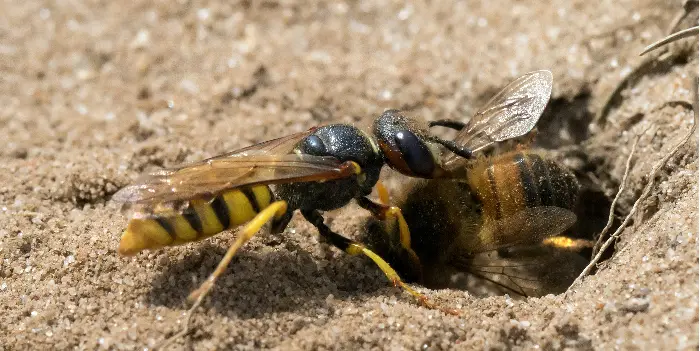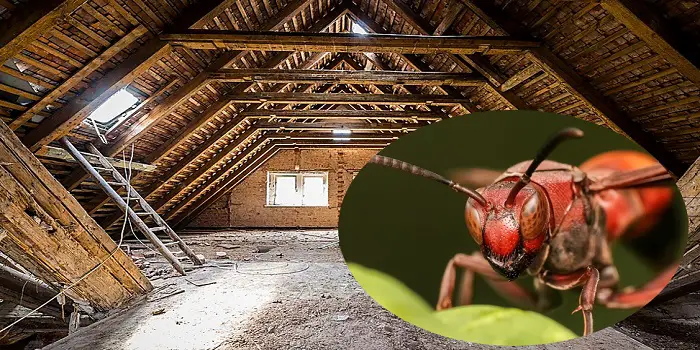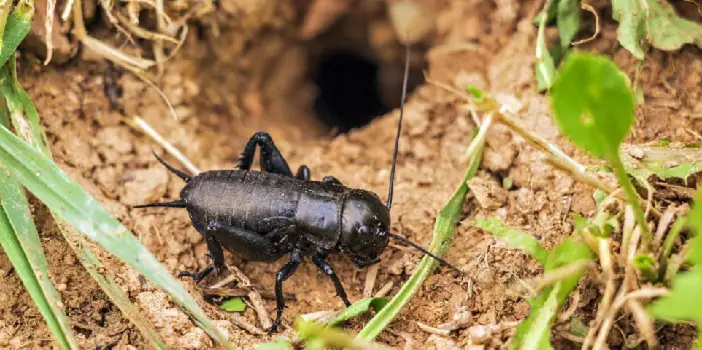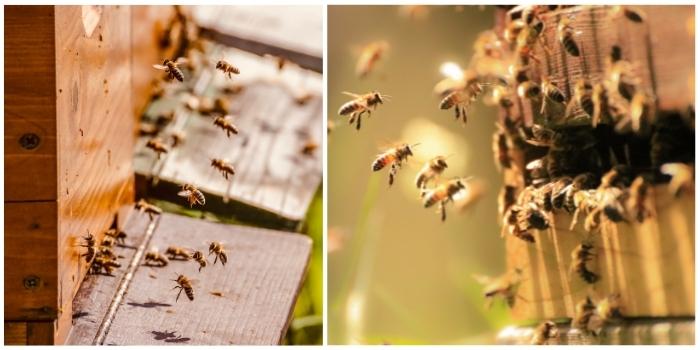
Although bees benefit the environment considerably, they can be pretty problematic to homeowners.
This is especially true when the beehive has been created inside the siding.
Bees are vital for the pollination of flowers, but they also can be dangerous to humans when they build their beehives inside the siding.
So, how can you safely remove the beehive and the bees from your home?
You do have several options, from killing the bees using the right chemicals or natural products such as boiling mint water.
You can create the natural concoction by combining two cups of peppermint castile soap with two cups of water. Also, take some boiling water in a jar.
Apply the peppermint mixture first and then the boiling water to the beehive at night when all the bees will be inside.
But what if the beehive is inside the siding, and you are not sure where it is located?
That does present a bigger problem.
Locating the Beehive in Siding
If the bees have set up their beehive inside the siding, all you are likely to see is the bees coming and going from the hole in the siding.
The beehive may be right next to the opening, or it may be several feet away.
However, before you can deal with the bees, you will need to find the beehive or beehives if two or more groups of bees have entered your siding.
The first step is to look around your home during the daytime and see if there are any other openings in the siding.
Make a note of where they are and if any bees are entering or exiting.
While bees like to set up their beehives well away from each other, they can set up their beehives on different exterior walls of your home.
Mark the areas where you see bees coming and going.
It’s also a good idea to seal up any areas where no bees are seen. This prevents the bees from finding a new place for a beehive.
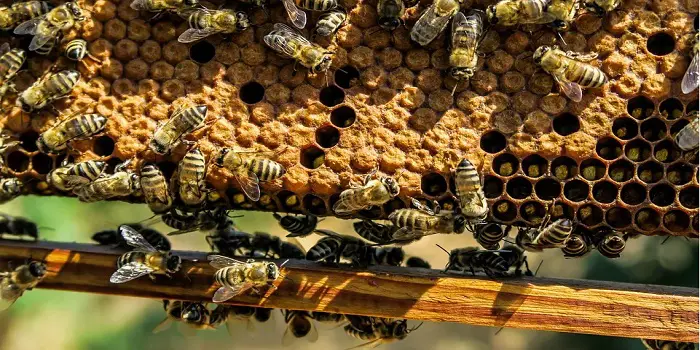
Identifying Bees – You Are Dealing With
Now that you know where the bees are entering and exiting your siding, the next step is to identify them.
The most common types of bees that will make your home their home are honeybees, bumblebees, and carpenter bees.
a) Bumblebee
This is a large bee that builds rather small beehives as they are relatively few.
For the most part, bumblebees do not sting unless you directly bother the beehive.
And unlike honeybees which can only sting once, a bumblebee may sting repeatedly.
b) Carpenter Bee
This bee looks a lot like a bumblebee.
The difference is that they are not nearly as fuzzy and have a black abdomen instead of a stripe – much like a bumblebee.
Carpenter bees do not build beehives but rather drill into the wood areas of the exterior.
The male carpenter bees do not sting but like to buzz around you.
The females might sting, but that is quite rare.
c) Honeybees
The most common type of bee creates beehives that may hold hundreds, if not thousands of bees.
They are considerably smaller than a bumblebee or carpenter bee, but they will sting you if they feel threatened.
That is why you should keep your distance from them during the day when they are active.
In addition to the bees, hoverflies, wasps, and yellow jackets may find a home inside your siding.
Ways to Get Rid of the Beehive in Siding
Once you have identified the bees, there are several ways to get rid of them.
1- Mint water
Boiling mint water has been mentioned as one of the natural methods.
The advantage of using natural substances such as boiling mint water is that they will not harm your home or other insects in the area.
You will need to protect yourself even if you are applying a pesticide or concoction at night.
The bees might still have enough light to see you.
- Wear Long Sleeves, Blue Jeans, Boots, Gloves, and a Hat with a Face Covering
- Use an Extension Pole to Put Some Distance Between You and the Beehive
Now you can pour the minty soap water on the nest, followed by the boiling water. Be sure to leave immediately once you do so.
2- Soda Pop
Another harmless substance you can use to bring down the population of bees is soda pop.
Start with an empty two-liter soda bottle.
Cut off the top and flip the top over and place it on top of the bottle.
It should look like a funnel going into the bottle itself.
Secure the top with tape but be sure to leave the opening untouched.
Now, pour a little soda inside the bottle and add a bit of dish soap.
Mix the concoction a little and place it near the beehive.
After a few days, you’ll find many bees inside, probably dead.
This will not get rid of the entire hive, but it will cut down their numbers considerably.
Now you can use other methods to get rid of the beehive.
3- Insecticide Dust
With the beehive population reduced, you can now use insecticide dust to kill the rest of them.
Obtain the dust from a local retail store that sells insecticides.
Then, put on your protective clothing and go out at night.
Dust the entrance in the siding where the bees come in and out.
The bees will collect the dust on their feet and carry it into the beehive.
It may take two or three applications, but this should kill all the bees inside.
Wait two to three days before applying another round of dust.
4- Beehive Sprays
If you can see the hive, then you can use a spray to directly kill the bees.
You’ll want to focus on the entrance with the spray and again do this at night.
Once you have sprayed the entrance, shove in some rags so the bees cannot leave.
Wait a few days and check; you may need to respray the entrance.
You should always consider your own safety first when dealing with a beehive.
Going out at night, covering all areas of your skin, and getting away quickly after applying the concoction, spray, or dust minimizes the chances of getting stung.
However, there is always the possibility that a bee or two may get out and sting you.
If you are allergic to bee stings, you should call the services of a professional.
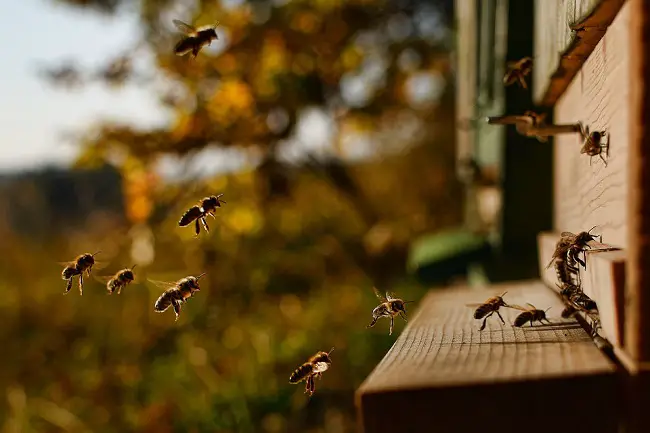
How to Move a Beehive with the Help of a Beekeeper?
If you do not want to kill the beehive and instead have them safely moved, a beekeeper can do the job.
Since many beekeepers would love the opportunity to have more bees on their property, many may perform the service for a low cost.
You may also want to keep the bees on your property if you want the honey they produce.
1- Choose the Right Area:
You’ll want to move the hive well away from your home.
But it should be in a place exposed to the morning sun so the bees will be more active.
Plus, an area that shades the hive when the sun goes down.
You should find that combination or create an area for the new beehive.
But what if you want the bees totally off your property? Then you will need to move the next one at least three miles away.
That is because if the hive produces a new queen, she and some worker bees may fly off to find another nest, and now you have the same problem again.
2- Place a Screen Over the Entrance:
If you are moving the hive in one piece, you will need to place a screen over the entrance.
This will allow the bees to have air while not being able to escape.
You will need to make a move after the bees stop flying in the evening hours.
You’ll also need to wear a full beekeeper’s outfit for maximum protection.
3- Secure the Hive Boards:
If you have moved the bees inside their new beehive, you will need to secure the hive boards before moving the unit.
Otherwise, you risk the boards falling away from the hive and causing the bees inside to get aggressive.
With the hive boxes, you should secure the boards and separate the hives with a screen.
This will provide some cover for the bees and allow them to breathe.
4- Open After Dark:
Once you have moved the hive to its new location, wait until dark before opening up the beehive.
The bees are far less active during the night, and you can remove the single screen away from the hive box.
The next evening, remove the remaining screens from the components and allow the hive to be properly restored.
Always be sure to wear protective clothing whenever you are near the bees, even at night.
By protecting yourself, you can also protect the bees as well.
This can have considerable benefits, especially if you enjoy natural honey.
The production of honey not only provides a treat for you and your family, but it is also something that may be sold as well.
Although given the overall cost of honey, how much you make will depend on how much you produce.
Why is Hiring a Professional Recommended for Beehive Removal?
There is no shame in hiring a professional beekeeper to do the work of moving the hive.
They are fully trained, protected, and have all the equipment necessary to perform the task.
Of course, this will cost you more money if you are moving the hive to another part of your property.
But the lower risk to you, your family, and your pets will be worth it.
A professional can either get rid of or relocate the beehive.
If possible, you should always try to keep the bees alive and move them to another location without actually killing them.
The Conclusion
Bees and humans get along best when they are a good distance apart.
But the truth is bees provide strong benefits to the health of the environment, even if bees and humans do not get along all that well.
By keeping the hive intact and moving it to a place that is well away from humans, you can keep the circle of life going in your area.
Share the post "How to Get Rid of Beehive in the Siding of My House?"

Welcome to ProShieldPest.com. I am Tina Jones. I have been working as a pest removal professional in Winslow, Arizona lately. At present, I love to spend my time with my family as a retiree.
Here I share all my knowledge and experiences to help people understand better how they can stop pests at their homes without actually killing them. Hopefully, the information you will find here will help in safeguarding your home! You can check more about me here.


